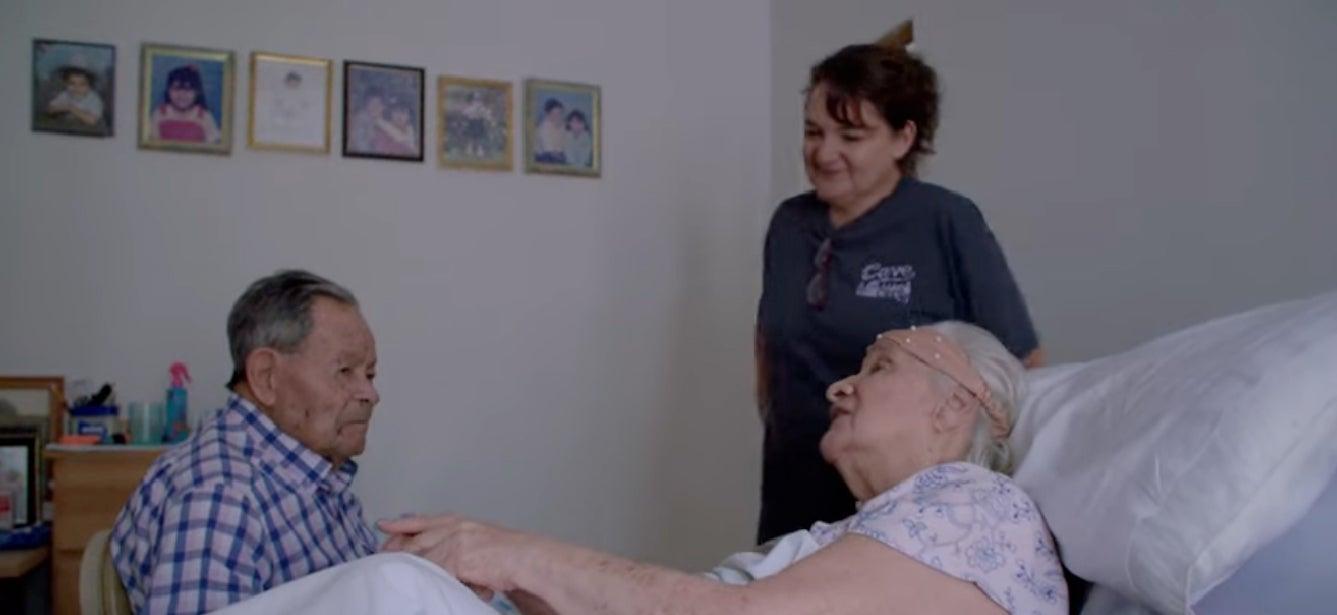
Related Topics
There is no cure for Alzheimer’s disease, and scientists don’t fully understand what causes this devastating form of dementia. But research shows that poor access to health care, lack of education, air pollution and other social and environmental factors leave people more vulnerable to the disease.
All these factors converge in the four counties that make up the Rio Grande Valley, a mostly rural, majority-Latino region where the infrastructure, education and health care systems suffer from decades of neglect. Medicare data shows that people here who are 65 and older are almost twice as likely to be diagnosed with dementia as people in that age group in most other parts of the country, according to the Centers for Medicare & Medicaid Services.1 In Starr County alone, one of the nation’s poorest, nearly 1 in 4 seniors had Alzheimer’s or a related dementia in 2021. That compares to 1 in 14 nationwide.
Texas region foreshadowing dementia rates nationwide
When it comes to dementia among Mexican Americans, South Texas is “at the tip of the spear,” said neurologist Sudha Seshadri, who directs the Glenn Biggs Institute for Alzheimer’s and Neurodegenerative Diseases at UT Health San Antonio.
In terms of the problems we’re going to face, other parts of the country are going to face it perhaps five to 10 years later,” Seshadri said.
Seshadri works with neuroepidemiologist Gladys Maestre, a professor at the University of Texas Rio Grande Valley School of Medicine, to better understand Alzheimer’s and related conditions in Mexican American communities. In 2021, the National Institute on Aging appointed them co-directors of a new, federally funded Alzheimer’s disease research center that has facilities at both of their universities. Together, they are looking at why so many cases are concentrated in South Texas and what, if anything, can be done to bring down the numbers.
Answering those questions is increasingly important because age is the biggest risk factor for dementia—and seniors are the fastest-growing segment of the U.S. population. Alzheimer’s is already the most expensive disease in the country,2 accounting for $355 billion in health care spending.3 That doesn’t include the economic cost of unpaid caregiving—an estimated $271 billion last year4—or the physical and emotional toll the disease takes on families and communities.
How research could unlock clues to help understand dementia
Research in Latino communities could unlock clues to these diseases that would help people of all ethnicities, said Sid O’Bryant, a neuroscientist at the University of North Texas Health Science Center. Latinos make up 19% of the U.S. population, and some studies show they have 1.5 times greater risk for dementia than white people without Hispanic ancestry. But so little research has been done within the Latino community that scientists don’t understand why.
Our whole goal is to understand brain aging, Alzheimer’s and dementia among all communities,” said O’Bryant, whose own grandmother died from Alzheimer’s.
The Rio Grande Valley occupies more than 4,000 square miles along the southernmost stretch of Texas, where it is separated from Mexico by the Rio Grande.
PV Villaseñor-Sandell lives in Weslaco, about 7 miles north of the border. She lost her father, businessman Jose Villaseñor Sr., to dementia in 2011.
Her father liked to keep a little cash in a pocket or stashed in a safe spot. As his dementia advanced, he confused tissues with money. After he died, Villaseñor-Sandell found tissues hidden throughout the house. She treasures some as keepsakes.
More than a decade later, she works as a fundraiser for the South Texas chapter of the Alzheimer’s Association. She hasn’t forgotten how frightening it was to confront a condition that’s so poorly understood and is alarmed by the rates of dementia she sees in the Valley.
What is happening to us in our community?” she asked. “Is it our diet? Is it where we live? Is it the grease … because, you know, who’s not making tortillas or carnitas?”
Lack of access to health care is likely one of the biggest contributors to dementia in the Valley because diabetes, heart disease and other health conditions increase the risk of Alzheimer’s and related dementias. The federal government classifies all four of the Valley’s counties as “medically underserved,” meaning they don’t have enough primary care doctors, dentists and other medical professionals. Finding specialists—including neurologists who can help diagnose and treat Alzheimer’s—is especially tough for rural residents.
One researcher's move to understand dementia among Latinos
Maestre moved to the Valley in 2016 to study healthy brain aging at The University of Texas Rio Grande Valley (UTRGV). She has a medical degree from her native Venezuela and a doctorate in neurobiology and behavior from Columbia University. She spent more than two decades studying Venezuelan communities hit hard by Alzheimer’s.
From the moment Maestre and her husband arrived in the Valley, it felt like home to them. But she said some public health workers and academics were skeptical about her growing interest in dementia among Latinos.
“People here told me that Mexican Americans don’t get Alzheimer’s,” she said.
Maestre began to wonder whether “a culture of denial” was keeping Latinos from admitting that they or their loved ones had the disease. When she met with families in nursing homes or gave talks at community meetings, people would pull her aside, whispering even, to say they were concerned about a parent or grandparent who had a memory problem. After the Pixar movie “Coco” was released, Maestre used it as a reference point to talk about dementia. The movie depicts an elderly Mexican woman named Coco whose memory is beginning to fade.
I would ask, ‘Do you have a Coco at home?’ A lot of people say ‘yes,’” Maestre said. “Some people say ‘I am Coco!’”
Some of the people she met assumed that memory loss and confusion were normal aspects of aging. Some believed dementia strikes people who deserve it — that a person’s poor diet, heavy drinking or bad sleeping habits caught up with them. For some, acknowledging the disease was a source of shame. Others worried that talking about a relative’s dementia was tantamount to admitting their own vulnerability to the disease.
Two years after Maestre moved to Texas, she was named director of the newly created Alzheimer’s Disease Resource Center for Minority Aging Research at UTRGV. Three years later, she and Seshadri became collaborators.
So far, Maestre suspects the occurrence of dementia in the Valley could be even higher than the Medicare data suggests. Residents who don’t visit doctors don’t show up in the data. Others may be too embarrassed to tell their doctors about memory problems.
But the number of cases could also be lower, Maestre says, because diagnosing dementia is so difficult. Depression, medication side effects, hearing loss and other conditions can produce changes that look like dementia. Misdiagnosis may be especially common among older patients with limited English skills because doctors can mistake incorrect responses to screening questions as signs of confusion or memory loss. And doctors can’t confirm an Alzheimer’s diagnosis without costly brain imaging or an invasive medical procedure.
Determining the true scope of dementia here could help answer questions about how Alzheimer’s and related diseases affect Hispanic communities more broadly. In the next 40 years, Latinos are on track to see the steepest increase in dementia diagnosis of any racial or ethnic group, yet they make up less than 5% of participants in clinical trials. Most previous studies of Alzheimer’s and related conditions recruited relatively affluent and educated white participants...
Continuing reading on Public Health Watch.
Read the Spanish-language version: Por qué el sur de Texas es el epicentro de un aumento de casos de alzhéimer que aqueja a muchas familias hispanas
This article—part of a collaboration between Public Health Watch and Univision—is excerpted here with with permission from Public Health Watch, a nonprofit, nonpartisan investigative news organization that focuses on threats to America’s well-being.
Sources
1. Centers for Medicare & Medicaid Services. Mapping Medicare Disparities by Population. Found on the internet at https://data.cms.gov/tools/mapping-medicare-disparities-by-population
2. Alzheimer's Association. Found on the internet at https://act.alz.org/site/DocServer/112114_Most_Expensive_Disease_Handout.pdf?docID=40161
3. Katie Macklin. On the Frontlines of the Alzheimer's Crisis. Delaware Journal of Public Health. Sept. 27, 2021. Found on the internet at https://www.ncbi.nlm.nih.gov/pmc/articles/PMC8482991/
4. National Council of State Legislatures. Caring for the Caregivers: State Strategies to Support an Unpaid Workforce. June 2022. Found on the internet at https://www.ncsl.org/health/caring-for-the-caregivers-state-strategies-to-support-an-unpaid-workforce



